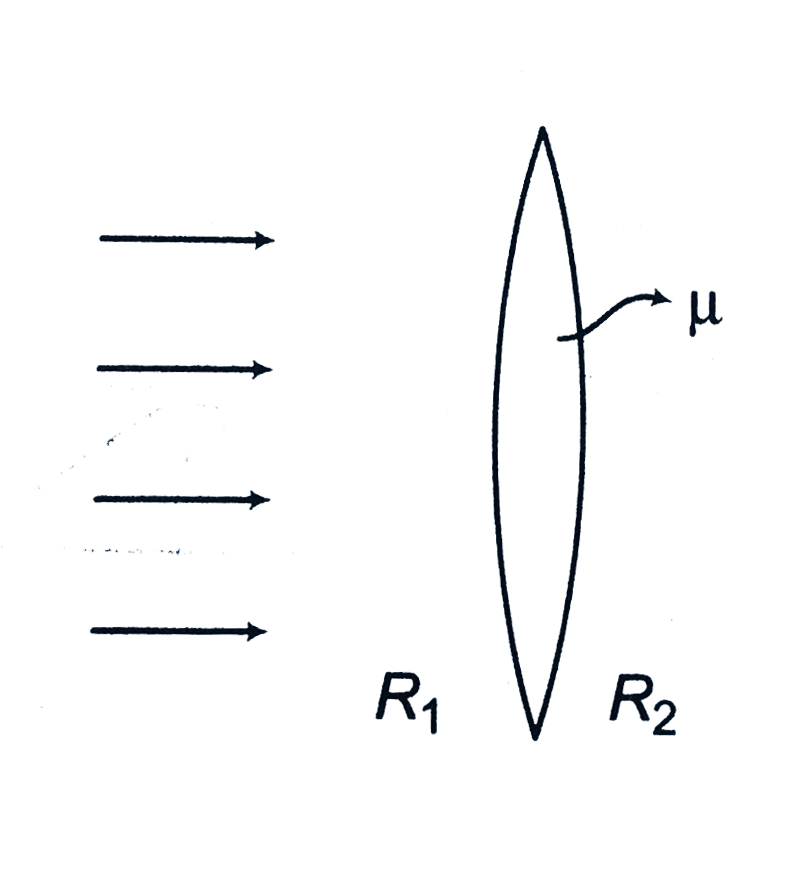A biconvex lens has a radius of curvature of magnitude 20cm. Which one of the following options describes best the image formed of an object of height 2cm place 30cm from the lens ?
Virtual, upright, height= 0.5cm
Real, inverted, height=4cm
Real, inverted, height =1cm
Virtual, upright, height=1cm
The correct Answer is:B
To solve the problem step by step, we will follow these calculations:
Step 1: Identify the given parameters
- Radius of curvature (R) = 20 cm
- Object distance (u) = -30 cm (the negative sign indicates that the object is placed on the same side as the incoming light)
- Height of the object (h) = 2 cm
Step 2: Calculate the focal length (f) of the lens using the lensmaker's formula
The lensmaker's formula for a biconvex lens is given by:
1f=(n−1)(1R1−1R2)
For a biconvex lens:
- n=32 (refractive index of glass)
- R1=+20cm (first surface, convex)
- R2=−20cm (second surface, concave)
Substituting the values:
1f=(32−1)(120−(−120))
=12(120+120)=12(220)=120
Thus, the focal length f=20cm.
Step 3: Use the lens formula to find the image distance (v)
The lens formula is given by:
1f=1v−1u
Substituting the known values:
120=1v−1−30
This simplifies to:
120=1v+130
To solve for 1v:
1v=120−130
Finding a common denominator (60):
1v=360−260=160
Thus, v=60cm.
Step 4: Calculate the magnification (m)
The magnification formula is given by:
m=h′h=vu
Where h′ is the height of the image and h is the height of the object. Substituting the values:
m=60−30=−2
This means the height of the image h′ can be calculated as:
h′=m⋅h=−2⋅2=−4cm
Step 5: Interpret the results
The negative sign of the height indicates that the image is inverted. Since the image distance v is positive, it indicates that the image is real.
Final Conclusion
The image formed is real, inverted, and has a height of 4 cm.
- Radius of curvature (R) = 20 cm
- Object distance (u) = -30 cm (the negative sign indicates that the object is placed on the same side as the incoming light)
- Height of the object (h) = 2 cm
The lensmaker's formula for a biconvex lens is given by:
1f=(n−1)(1R1−1R2)
For a biconvex lens:
- n=32 (refractive index of glass)
- R1=+20cm (first surface, convex)
- R2=−20cm (second surface, concave)
1f=(32−1)(120−(−120))
=12(120+120)=12(220)=120
Thus, the focal length f=20cm.
The lens formula is given by:
1f=1v−1u
Substituting the known values:
120=1v−1−30
This simplifies to:
120=1v+130
To solve for 1v:
1v=120−130
Finding a common denominator (60):
1v=360−260=160
Thus, v=60cm.
The magnification formula is given by:
m=h′h=vu
Where h′ is the height of the image and h is the height of the object. Substituting the values:
m=60−30=−2
This means the height of the image h′ can be calculated as:
h′=m⋅h=−2⋅2=−4cm
The negative sign of the height indicates that the image is inverted. Since the image distance v is positive, it indicates that the image is real.
The image formed is real, inverted, and has a height of 4 cm.
Similar Questions
A biconvex lens (μ=1.5) has radius of curvature 20cm (both).
find its focal length.

View SolutionA biconvex lens has radii of curvature 20 cm and 40cm. The refractive index of the material of the lens is 1.5. An object is placed 40cm in front of the lens. Calculate the psition of the image.
View Solution
Knowledge Check
A convex lens of focal length 15 cm is placed on a plane mirror. An object is placed at 30 cm from the lens. The image is
Areal, at 30 cm in front of the mirrorBreal, at 30 cm behind the mirrorCreal, at 10 cm in front of the mirrorDvirtual, at 10 cm behind the mirrorThe power of a biconvex lens is 10 dioptre and the radius of curvature of each surface is 10 cm. Then the refractive index of the material of the lens is
A32B43C98D53
A plano convex lens of refractive index 1.5 and radius of curvature 30cm. Is silvered at the curved surface. Now this lens has been used to form the image of an object. At what distance from this lens an object be placed in order to have a real image of size of the object.
View SolutionIf in a planoconvex lens, the radius of curvature of the convex surface is 10cm and the focal length is 30cm, the refractive index of the material of the lens will be
View SolutionA convex mirror has its radius of curvature 20 cm. Find the position of the image of an object placed at a distance of 12 cm from the mirror.

View SolutionA convex lens has a focal length of 20 cm. It is used to form an image of an object placed 15 cm from lens. The image is
View SolutionA biconvex lens of focal length 15cm is in front of a plane mirror. The distance between the lens and the mirror is 10cm. A small object is kept at distance of 30cm from the lens. The final image is
View SolutionA beam of light coming from infinty is passing through a biconvex lens having radius of curvature R=20cm of each surface, if focused at a certain distance from lens. Find the radius of curvature of emergent wave front from lens : (μ≤ns=1.5)
View Solution
